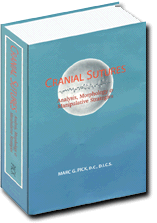| Title: | Cranial Sutures: Analysis, Morphology & Manipulative Strategies |
| Author: | Marc Pick, DC |
| Publisher: | Eastland Press, Seattle, WA |
| Copyright Date: | 1999 |
| Publication: | Hardcover, 469 pages |
| Price: | $80.00 |
| Part #: | T-222.
|
 Most practitioners don't have much experience with cranial work, and they have little with which to compare it. Two questions come to mind immediately. The first is, why study craniopathy? The easy answer is, because eighty percent of the central nervous system is above the foramen magnum. Work on the cranium can ameliorate headaches, some of the effects of head trauma, and even stroke; in fact, there are probably no known conditions that do not have a cranial component.
Most practitioners don't have much experience with cranial work, and they have little with which to compare it. Two questions come to mind immediately. The first is, why study craniopathy? The easy answer is, because eighty percent of the central nervous system is above the foramen magnum. Work on the cranium can ameliorate headaches, some of the effects of head trauma, and even stroke; in fact, there are probably no known conditions that do not have a cranial component.
Many people believe the cranial field is one of the largest growth areas in chiropractic. Cranial work was originated by the osteopath Dr. William Garner Sutherland and brought to chiropractic by Dr. Major Bertrand DeJarnette, who had osteopathic training and probably studied with Dr. Sutherland.
Now to the second question: Why Dr. Marc Pick? Dr. Pick studied with Dr. DeJarnette, and did quite a bit of his own research. Those of you fortunate enough to know him realize he's a Renaissance man: chiropractor; scientist; writer; craftsman; and artist. His lectures and presentations on cranial work are among the best experienced by this reviewer. Cranial Sutures is no exception.
Craniopathy is the study of physiological and pathological movements of the cranial vault, facial bones and sutures. Cranial sutures are unique articulations that include gomphosis; schindylesis; synchondroses; denticulate; squamous; serrated; limbous; and plane types. This book is broken down into three sections: sutural palpatory techniques; sutural morphology and manipulative techniques; and manipulative strategies (tuina). It also includes contacts for palpation, normal findings, and contacts with manipulation. This text is beyond complete; it's exhaustive.
There are many other books on cranial work, but nothing in this class. It is an atlas and a technique book. In fact, if you read only one book on sutural technique, this is the one. It is a good introduction for the beginner; interesting for the intermediate; and pure gold for the advanced craniopath. If knowledge is power, the chiropractor who reads and studies this text can do more good than the uninitiated can imagine.
Dr. Lavitan's rating:
If you have authored, published or produced a book, audio or video package that is chiropractic-oriented, educational, nonpromotional and written or produced in a professional manner, and would like it reviewed in Dynamic Chiropractic, please send two copies of the book, video or audiocassette to:
Dynamic Chiropractic
P.O. Box 4109
Huntington Beach, California 92605-4109
Items submitted for review will not be returned.





